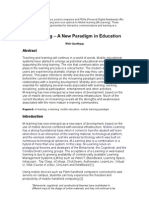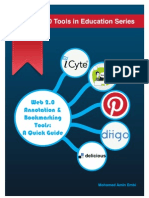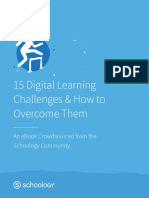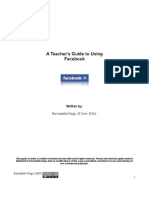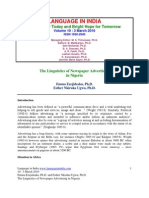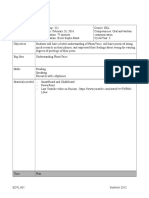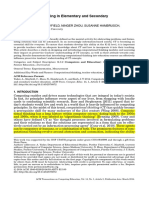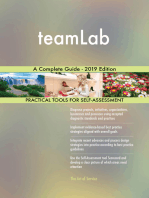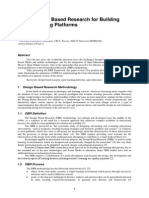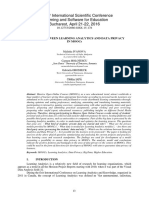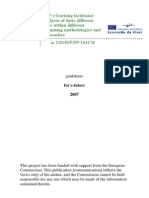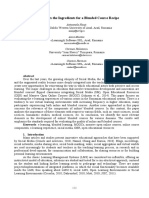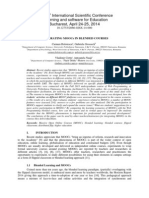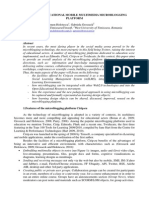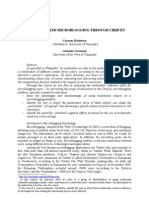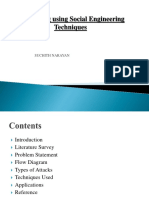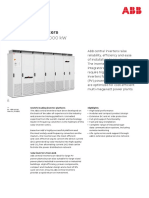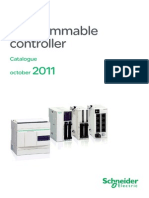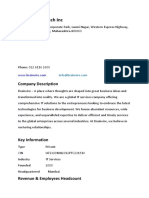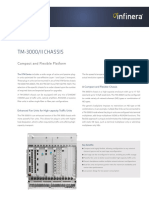Professional Documents
Culture Documents
Using Microblogging in Education. Case Study: Cirip
Uploaded by
Carmen Holotescu100%(8)100% found this document useful (8 votes)
4K views4 pagesArticle about using the microblogging platform Cirip.ro - http://www.cirip.ro/?lg=en ( http://tinyurl.com/browsingCirip ) - to run online courses and to enhance traditional courses.
Submitted to the 6th Conference on e-Learning Applications, Cairo, Jan 2009
See also http://www.scribd.com/doc/2286799/Can-we-use-Twitter-for-educational-activities
Original Title
Using microblogging in education. Case Study: Cirip.ro
Copyright
© Attribution Non-Commercial (BY-NC)
Available Formats
PDF, TXT or read online from Scribd
Share this document
Did you find this document useful?
Is this content inappropriate?
Report this DocumentArticle about using the microblogging platform Cirip.ro - http://www.cirip.ro/?lg=en ( http://tinyurl.com/browsingCirip ) - to run online courses and to enhance traditional courses.
Submitted to the 6th Conference on e-Learning Applications, Cairo, Jan 2009
See also http://www.scribd.com/doc/2286799/Can-we-use-Twitter-for-educational-activities
Copyright:
Attribution Non-Commercial (BY-NC)
Available Formats
Download as PDF, TXT or read online from Scribd
100%(8)100% found this document useful (8 votes)
4K views4 pagesUsing Microblogging in Education. Case Study: Cirip
Uploaded by
Carmen HolotescuArticle about using the microblogging platform Cirip.ro - http://www.cirip.ro/?lg=en ( http://tinyurl.com/browsingCirip ) - to run online courses and to enhance traditional courses.
Submitted to the 6th Conference on e-Learning Applications, Cairo, Jan 2009
See also http://www.scribd.com/doc/2286799/Can-we-use-Twitter-for-educational-activities
Copyright:
Attribution Non-Commercial (BY-NC)
Available Formats
Download as PDF, TXT or read online from Scribd
You are on page 1of 4
USING MICROBLOGGING IN EDUCATION. CASE STUDY: CIRIP.
RO
Using microblogging in education.
Case Study: Cirip.ro
Carmen Holotescu1, Gabriela Grosseck2
1 Technical University, Department of Computer Science, Timisoara, Romania
2 University of the West Timisoara, Department of Social Informatics, Romania
Abstract—Microblogging is the Web2.0 technology with the
most important impact in 2008, with applications in many II. MICROBLOGGING WITH CIRIP – CURRENT ISSUE
domains, including education. On a microblogging platform, Cirip.ro is a microblogging platform specially designed
the users can send and receive messages via the web, SMS, for education and business, launched this year in March,
instant messaging clients, and by third party applications; implemented by Timsoft, a company specialized in e-
the most known platform is Twitter. With a solid experience learning and mobile applications, under the first author's
in using Web2.0 technologies in education, the authors are coordination. The platform has many educational uses, for
trying to provide arguments for using microblogging information and knowledge management, for courses
platforms in education, underlining the advantages, but also enhancement, for delivering entire online courses, for
possible bad points. The article presents a microblogging collaborative projects in universities, for communities of
platform specially designed for education, called Cirip.ro,
practice, or for eportfolios.
which offers facilities such as live video / audio messages,
multimedia objects embedding, private and public groups, Besides the facilities that Twitter offers, Cirip.ro comes
feeds monitoring. Some concrete examples are presented, in with the following:
which the platform is used for courses enhancement, for Users have the possibility to specify the domain
communities of practice, but also for delivering entire online about which they will write the notes; this makes
courses. How to facilitate such projects, how to integrate finding microblogs from a specific domain easier,
other Web2.0 technologies, how to evaluate students particularly the educational ones;
portfolios and participation are underlined too.
Creating user groups; pupils, students, teachers can
Index Terms—Web2.0, collaborative technologies,
create public or private groups(in the private ones
microblogging, education, social learning the notes are visible only for members);
The possibility to embed images, audio and (live)
video files, presentations, documents in notes;
I. INTRODUCTION The possibility to subscribe to search feeds or to
Microblogging is a Web2.0 technology and a new form feeds offered by sites / blogs / social networks –
of blogging, that let the users publish online brief text the same as users and groups, the feeds can be
updates, usually less then 140-200 characters, sometimes monitored, online, by IM, or by SMS.
images too. The posts can be edited and accessed online, The interface is in Romanian and in English, facilitating
or sent as SMS, e-mail or via instant messaging clients. an international collaboration.
Usually the microblogs authors embed their posts as a
Many statistics and visual representations offered by
widget on blogs or sites.
platform are useful for quantitative and qualitative
Microblogging enables a real-time interaction between evaluation.
users, using different devices, technologies and
The platform has a few thousands users, an important
applications [1]. The best known microblogging services
percentage being pupils, students and teachers.
are Twitter, Tumblr, Pownce, and Jaiku [2] and, recently
Edmodo. There are also local microblogging systems, During June 4-18, 2008, the authors developed and
very appreciated among Romanian Internet users, like moderated an online course, in a private group. It is a
Cirip.ro, Zazazoo.ro and Logoree.ro. world premiere, the first online course developed and run
entirely on a microblogging platform.
Even though Twitter seems to be the most popular
microblogging system, recently teachers and students tend In the next paragraphs we will present the first entire
to use a special platform designed for education called online course run on Cirip.ro, which gave us the
Edmodo.com to send “notes, links, files, alerts, opportunity to gain valuable experience and to reach
assignments, and events to each other”. Other educational useful conclusions for the current courses run for different
uses of microblogging can be found in Ref [3] and [8]. universities or for continuos education.
The paper will describe the facilities of the The aim of this course was to find out if microblogging
microblogging platform Cirip.ro, and how it can be used can be integrated in the lifelong learning / teaching /
in education. collaboration / business / blogging. The topics addressed
were: microblogging platforms, Twitter facilities, Cirip.ro
facilities, uses in education, uses in business, uses in blogs
promotion etc.
USING MICROBLOGGING IN EDUCATION. CASE STUDY: CIRIP.RO
We wanted to investigate: Besides discussions and debates conducted by the wide
how to integrate microblogging with other Web2.0 range of messages we carried out a series of collaborative
technologies; exercises, which will be presented in the next section.
if a microblogging platform, in particular Cirip.ro, IV. PARTICIPATION IN DISCUSSIONS
can be used as a Learning Management System
(LMS), and if it has the needed facilities to run an Although initially 50 people have registered, 40 of them
online course; have actively participated. The participants were mainly
what are the differences between facilitating an educational actors (students, teachers, developers,
online course on such a platform and one in a librarians etc.). They appear in the members section of the
classic LMS. group (figure 2). For each member, the total number of
contributions in the group is listed. The Network option
shows a graphical representation for the group.
III. GROUP FACILITIES
The course was hosted and run in the private group
cursmb of the microblogging platform Cirip.ro.
A group has a special section for announcements
(Group News) - another original element of the platform,
where the moderators can post notes and useful materials
for the group activities (figure 1).
The authors have published in the announcements both
notes on the proposed activities and course resources
(mainly tutorials on course topics, with a variety of
multimedia elements).
The discussions on the proposed themes were realized
through messages sent by the participants in the group
space. Messages can be sent / monitored online (web site
or CiripFox – a Firefox extension) or as: SMS ( it’s simple
to track the group messages via mobile phone); instant
messages; e-mail (daily notices with followed messages,
answers, new followers or news are received by those who
activate this option); it is also possible to send e-mail
messages on Cirip.ro, including in groups.
Other valuable options are the facilities to send live Figure 2. Group Members section(42 members)
video / audio messages and to integrate multimedia
objects in the notes, all of them becoming part of the There were almost 1100 messages written in the group,
information / communication flow (eg. audio clips saved approximately 100 after the end of the course. On average,
on a server or vocaroo, audio clips from e-ok.ro, trilulilu each member wrote 25 messages, which demonstrates an
or deezer; flickr or tinypic images, youTube, seismic, interested participation, and involvement.
vimeo, veevo or dotsub videos; slideshare, voicethread or The Tagcloud group section (present for any microblog
flowgram presentations; pdf, docs or spreadsheet files too) allows interesting observations regarding the terms
etc.). that appear most often in messages, the most active users,
resources specified most frequently in messages.
In figure 3 one can see the 50 words that have appeared
most often in the last 500 messages.
Topics Tagcloud and Network are interesting features
of the groups created on the Cirip.ro platform, useful in
analysing the interactions in learning or practice
communities.
To evaluate the participants we have considered:
- number and quality of messages sent in course
group
- the eportfolio which consists of public and
private messages
- number of followers/followings/groups/feeds
- number of messages sent to other participants,
reactions to messages
- direct communication with other participants and
other users of the platform.
Figure 1. Group news, http://www.cirip.ro/grup/cursmb
The timeline, network, tagcloud sections of
microblogs and groups offer useful data for evaluation.
USING MICROBLOGGING IN EDUCATION. CASE STUDY: CIRIP.RO
6. A code of good practice on microblogs with
items written by the participants using the
collaborative platform writeboard.com.
One can observe: the most active members, nouns,
verbs, and notions that appeared most often in discussions,
participation and also a warm and open atmosphere
between participants.
VI. GENERAL REMARKS
The course promoted values and attitudes among
participants as followed in the lines bellow. Above all,
through the course we promoted an ambient awareness for
„communication, connections, and immediacy in 140
Characters at a time” [5], seldom seen in other on-line
Figure 3.Group Tagcloud learning situations:
interest in life-long learning; motivations and
flexibility in developing their own educational and
V. COLLABORATIVE ACTIVITIES AND THEIR RESULTS vocational route
In this section we offer an overview of the collaborative respect and confidence in themselves and others
activities carried out during the course, which involved the facilitate mutual awareness; responsiveness to the
use of other Web2.0 technologies. For most of the emotions of others
participants this was the first contact with them, so in
advance helpful information was offered: valuing interpersonal relations - to learn how to
take turns in speaking
1. Puzzle images - we proposed a combination
word - picture (Creative Commons from flickr) the course turned into an interface to own
experiences - developing the skills to meet the
to be associated with microblogs and / or demands of social life in general
microblogging. Towards the end of the course
this exercise was redone, to see if the opinion analysis of real needs and problems (examples:
How do I ...? Does anyone know if ..? etc.) and
about microblogging was changed during the
building polls (which are Ciriposphere verbs - the
course. metaphors of microblogging).
2. A collaborative collection on del.icio.us created
During the course the participants developed the public
during the course, which was enlarged and used
part of their microblogs: writing public messages,
after the course end. following and discussing with other users, validating the
3. Translation of “Twitter in Plain English” video, topics of the course, monitoring feeds, and being part in
which is part of the Common Craft Show other groups. After the course ended, they continue to
collection. Video is posted on dotsub.com, activate on the platform, communicating and collaborating
where the transcript was translated through with facilitators and other participants. This is an
collaborative editing a document on important advantage of this platform, the learning
writeboard.com. community continuing to be active after the course ended.
4. A voicethread object with text and audio The course has also allowed:
comments submitted by members. a wide variety of expression forms (voice, video,
5. Notes on a Flickr image. Starting from images etc.) using mashup tools already tested in
wordle.net, a resource suggested by a participant education, for communicating personal and
- TBD, a tagcloud (fig. 4) with the words that didactical experience
appeared most frequently in the aprox. first 600 the application of effective and flexible techniques
messages of the course was generated. in using microblogging in education
reversibility of messages
to build a set of best practices
promoting personal blogs
export microblogs notes on the blogs
"ambassadors" of ideas / concepts / events
humor, good mood.
There were also:
moments of inertia (see group timeline for
messages distribution in time)
certain technical constraints (do not forget that it is
a platform in continuous development and
Figure 4. Tagcloud made with Wordle, improvement), messages without dissipation
http://www.flickr.com/photos/cami13/2573662470/
USING MICROBLOGGING IN EDUCATION. CASE STUDY: CIRIP.RO
unequal contributions from participants curriculum microblogging can be built based on the
a certain degree of pollution or noise information. principle of learning spiral.
VII. CONCLUSIONS A ND FUTURE WORK
REFERENCES
For the authors of this paper, microblogging, and
[1] M., Ebner, M., Schiefner , Microblogging - more than fun? in
especially Cirip.ro, proved to be an effective tool for Proceedings of IADIS Mobile Learning Conference 2008,
professional development and for collaboration with Inmaculada Arnedillo Sánchez and Pedro Isaías ed., Portugal,
students, that can change the rules of the courses and 2008, p. 155-159.
models good pedagogy responsive to student's learning [2] Java et al., Why We Twitter: Understanding Microblogging Usage
needs. Furthermore, as a social networking / and Communities, 12August 2007,
microblogging platform, Cirip.ro provides valuable http://ebiquity.umbc.edu/paper/html/id/367/Why-We-Twitter-
interactions in educational context, acting as a social Understanding-Microblogging-Usage-and-Communities.
factor in a course management system [4]. [3] G., Grosseck, C., Holotescu., Can we use Twitter for educational
activities?, The 4th International Scientific Conference eLSE
We appreciate that the microblogging platform Cirip.ro "eLearning and Software for Education", Bucharest, April 17-18,
has facilities which permit delivering successful and 2008.
quality online courses; the communication, authoring, [4] N. Katz (editor), The tower and the cloud, Educause, 2008.
monitoring, statistical facilities make Cirip.ro a modern [5] S., Milstein, B., Lorica, Twitter and the Micro-Messaging
free LMS. Revolution: Communication, Connections, and Immediacy—140
To facilitate an entire online course or a part of a Characters at a Time, O’Reilly Media, 2008.
course on such a platform requires specific facilitation [6] C. Holotescu, Notes on microblogging,
http://www.timsoft.ro/weblog
skills, and collaborative technologies knowledge. The
[7] G. Grosseck, Notes on microblogging,
effort and time needed are more important than those for http://grosseck.blogspot.com
an online course hosted on a clasic LMS. We would [8] D. Parry, Twitter for Academia, January 23rd 2008,
recommend to run entire online courses on Cirip.ro only if http://academhack.outsidethetext.com/home/2008/twitter-for-
the course duration is of a few weeks, otherwise the academia/
facilitation and communication become too demanding for [9] Rob Koper, Colin Tattersall: Learning Design - A Handbook on
teachers and students. Modelling and Delivering Networked Education and Training,
Future developments: Springer, 2005.
Tags will be implemented to classify notes and to
organize the groups mesages in topics defined by the
facilitator.
The authors intend to develop a specification for AUTHORS
evaluating students eportfolio and participation in
Carmen Holotescu is the manager of Timsoft, an
courses run or enhanced by microblogging. eLearning company and junior lecturer, Ph.D. Candidate
Scenarios for using microblogging together with at Politehnica University, Department of Computer
different collaborative technologies in formal and Science, Timisoara, Romania (cami@timsoft.ro)
informal courses will be modelled using Educational
Modelling Language[9]. Gabriela Grosseck is senior lecturer, Ph.D., at
In conclusion, respecting the learning time budget, each Department of Social Informatics, Faculty of Sociology
teacher can choose to use microblogging to enhance and Psychology University of the West Timisoara,
her/his courses. This is the option recommended by the Romania (ggrosseck@socio.uvt.ro)
authors of this material due to the following
considerations: the need for personal development and Published as submitted by the author(s).
planning issues related to the future course and a
You might also like
- Can We Use Twitter For Educational Activities?Document11 pagesCan We Use Twitter For Educational Activities?Gabriela Grosseck100% (35)
- Edmodo: A Guide To It AllDocument53 pagesEdmodo: A Guide To It AllPatrick Cauley100% (3)
- M-Learning - A New Paradigm in EducationDocument8 pagesM-Learning - A New Paradigm in Educationdr gawdat100% (4)
- Evolving A New Marketing Mix For Selling To Rural IndiansDocument12 pagesEvolving A New Marketing Mix For Selling To Rural IndiansDr Rahul Mirchandani100% (15)
- Effective Web 2.0 Tools For The Classroom: Part 2Document322 pagesEffective Web 2.0 Tools For The Classroom: Part 2Dr Johan @ Eddy LuaranNo ratings yet
- Twitter in K-8 Classroom - Globally Connected LearningDocument10 pagesTwitter in K-8 Classroom - Globally Connected LearningSilvia Rosenthal Tolisano100% (3)
- 888 Fourth Lecture CoPDesignGuideDocument8 pages888 Fourth Lecture CoPDesignGuideKaiser KhanNo ratings yet
- Web 2.0 Annotation and Bookmarking Tools: A Quick GuideDocument111 pagesWeb 2.0 Annotation and Bookmarking Tools: A Quick GuideProfDrAmin100% (2)
- Web 2.0-Based E-Learning (Livro)Document518 pagesWeb 2.0-Based E-Learning (Livro)anibalguedes925575% (4)
- Syllabus: Digital Media Economics at UNC School of Journalism and Mass CommunicationDocument9 pagesSyllabus: Digital Media Economics at UNC School of Journalism and Mass CommunicationRyan Thornburg100% (1)
- Mobile LearningDocument22 pagesMobile Learningu065932No ratings yet
- E-Learning in Malaysian Higher Education InstitutionsDocument166 pagesE-Learning in Malaysian Higher Education InstitutionsProfDrAmin100% (1)
- Lecturer ManualDocument30 pagesLecturer ManualAndrew JoriNo ratings yet
- Social MediaDocument80 pagesSocial MediaCall Central USA ITNo ratings yet
- Module Multimedia PDFDocument94 pagesModule Multimedia PDFNoor Ismala Ishak100% (1)
- Hootsuite TutorialDocument168 pagesHootsuite TutorialLeandroSabadoNo ratings yet
- Social Media Strategy, Fall 2018 - SyllabusDocument5 pagesSocial Media Strategy, Fall 2018 - SyllabusJohn A. McArthurNo ratings yet
- 15 Digital Learning Challenges & How To Overcome Them PDFDocument21 pages15 Digital Learning Challenges & How To Overcome Them PDFBayu AndoroNo ratings yet
- Google Slide TutorialDocument21 pagesGoogle Slide TutorialRicarla AlvarezNo ratings yet
- GST 105 History and Philosophy of ScienceDocument114 pagesGST 105 History and Philosophy of ScienceOoar ServicesNo ratings yet
- Teacher Training Workshop TemplateDocument3 pagesTeacher Training Workshop TemplateNope KnopeNo ratings yet
- A New Age Solution To All Learning and Development NeedsDocument12 pagesA New Age Solution To All Learning and Development Needsmac lundiNo ratings yet
- Marketing Seminar For Small BusinessDocument79 pagesMarketing Seminar For Small Businessscoredocs100% (42)
- Teacher's Guide To Using Facebook (Read Fullscreen)Document22 pagesTeacher's Guide To Using Facebook (Read Fullscreen)Bernadette Rego100% (23)
- Reforming and RetweetingDocument16 pagesReforming and RetweetingGeorge Ford100% (1)
- Multimedia FoundationsDocument32 pagesMultimedia FoundationsDani SaitoNo ratings yet
- Knowledge Management Systems Life CycleDocument33 pagesKnowledge Management Systems Life CyclePooja Prateek JoshiNo ratings yet
- Sundar Limperos 2013 Uses and Grats 2 0Document22 pagesSundar Limperos 2013 Uses and Grats 2 0Ana-Maria PremecNo ratings yet
- Game Based LearningDocument37 pagesGame Based LearningPanji UntoroNo ratings yet
- The Internet As A New Platform For Expressing Opinions and As A New Public SphereDocument9 pagesThe Internet As A New Platform For Expressing Opinions and As A New Public SphereFrancis Voltaire Dean OscarisNo ratings yet
- Types of Social Media PDFDocument2 pagesTypes of Social Media PDFVaishali KhannaNo ratings yet
- D28 Plan & PitchDocument8 pagesD28 Plan & PitchMike LeungNo ratings yet
- Taking Notes in The Digital AgeDocument39 pagesTaking Notes in The Digital AgeKen SappNo ratings yet
- Moodle Hints Tips Tricks-SweetinDocument26 pagesMoodle Hints Tips Tricks-SweetinsnoutzNo ratings yet
- Ad in NigeriaDocument17 pagesAd in NigeriaMazri MnNo ratings yet
- Research AssignmentDocument29 pagesResearch AssignmentUmar Hanif0% (1)
- Open Educational Resources Publication by G.Umakanthan (OUSL Batticaloa)Document2 pagesOpen Educational Resources Publication by G.Umakanthan (OUSL Batticaloa)Anonymous A6BIMANo ratings yet
- PR2600 2015-2016 Syllabus PDFDocument41 pagesPR2600 2015-2016 Syllabus PDFMacaMartinNo ratings yet
- MDDE 610: Redesign Inititaive Part 1Document16 pagesMDDE 610: Redesign Inititaive Part 1RaavenwingNo ratings yet
- Nguyễn Diệu Anh Phạm Ngọc Mai Trần Diễm Quỳnh Vũ Thu VânDocument28 pagesNguyễn Diệu Anh Phạm Ngọc Mai Trần Diễm Quỳnh Vũ Thu VânDiệu AnhhNo ratings yet
- Digital Labour and Karl Marx.: 1st Edition. by Christian Fuchs (Author)Document11 pagesDigital Labour and Karl Marx.: 1st Edition. by Christian Fuchs (Author)Mel Ward100% (1)
- Photovoice - Lesson PlanDocument3 pagesPhotovoice - Lesson Planapi-306133503No ratings yet
- Berker Et Al - Domestication of Media and TechnologyDocument141 pagesBerker Et Al - Domestication of Media and TechnologyMatt SigotNo ratings yet
- Poell, Thomas, David Nieborg & José Van Dijck - (2019) PlatformisationDocument13 pagesPoell, Thomas, David Nieborg & José Van Dijck - (2019) PlatformisationFranz KafkaNo ratings yet
- Codes and Conventions Handout UalDocument3 pagesCodes and Conventions Handout Ualapi-370519901No ratings yet
- J463 Top Social Media Journalism Fall 2019 v6 (12.01.19)Document20 pagesJ463 Top Social Media Journalism Fall 2019 v6 (12.01.19)Damian RadcliffeNo ratings yet
- Yadav - Computational Thinking in Elementary and Secondary Teacher EducationDocument16 pagesYadav - Computational Thinking in Elementary and Secondary Teacher EducationakousisNo ratings yet
- A Learning Design Toolkit To Create Pedagogically Effective Learning Activities Grainne Conole, Karen FillDocument16 pagesA Learning Design Toolkit To Create Pedagogically Effective Learning Activities Grainne Conole, Karen FillTom Waspe TeachNo ratings yet
- Advanced Social Media Syllabus 2017Document6 pagesAdvanced Social Media Syllabus 2017Mindy McAdamsNo ratings yet
- Google Classroom Student User Manual: August 2018, Volume 1Document28 pagesGoogle Classroom Student User Manual: August 2018, Volume 1Selina Trish MikaNo ratings yet
- Moodle WizardDocument49 pagesMoodle WizardFrank ChuksNo ratings yet
- Greenwash DigitalDocument22 pagesGreenwash DigitalAl Mamun AhmedNo ratings yet
- Online and Distance Education for a Connected WorldFrom EverandOnline and Distance Education for a Connected WorldLinda Amrane-CooperNo ratings yet
- The Amsterdam Diary: An Exploration of Learning CultureFrom EverandThe Amsterdam Diary: An Exploration of Learning CultureRating: 4 out of 5 stars4/5 (1)
- Computer Assisted Learning: Selected Proceedings from the CAL 81 Symposium, University of Leeds, 8-10 April 1981From EverandComputer Assisted Learning: Selected Proceedings from the CAL 81 Symposium, University of Leeds, 8-10 April 1981Rating: 5 out of 5 stars5/5 (2)
- Using Design Based Research For Building Open Learning PlatformsDocument6 pagesUsing Design Based Research For Building Open Learning PlatformsCarmen HolotescuNo ratings yet
- Understanding Blockchain Technology and How To Get InvolvedDocument8 pagesUnderstanding Blockchain Technology and How To Get InvolvedCarmen HolotescuNo ratings yet
- MOOCs For Innovative Entrepreneurship in Smart CitiesDocument6 pagesMOOCs For Innovative Entrepreneurship in Smart CitiesCarmen HolotescuNo ratings yet
- Relations Between Learning Analytics and Data Privacy in MOOCsDocument8 pagesRelations Between Learning Analytics and Data Privacy in MOOCsCarmen HolotescuNo ratings yet
- Guidelines For E-TutorsDocument53 pagesGuidelines For E-TutorsCarmen HolotescuNo ratings yet
- How To Mix The Ingredients For A Blended Course RecipeDocument11 pagesHow To Mix The Ingredients For A Blended Course RecipeCarmen HolotescuNo ratings yet
- Romanian Projects Related To Open Educational Resources and PracticesDocument31 pagesRomanian Projects Related To Open Educational Resources and PracticesCarmen HolotescuNo ratings yet
- Emerging Technologies in Education. Conceiving and Building A Microblogging Platform For Formal and Informal LearningDocument213 pagesEmerging Technologies in Education. Conceiving and Building A Microblogging Platform For Formal and Informal LearningCarmen HolotescuNo ratings yet
- Exploring OERs and MOOCs For Learning of EU LanguagesDocument6 pagesExploring OERs and MOOCs For Learning of EU LanguagesCarmen HolotescuNo ratings yet
- A Methodology For Developing Blended Courses Integrated With Web 2.0 TechnologiesDocument8 pagesA Methodology For Developing Blended Courses Integrated With Web 2.0 TechnologiesCarmen HolotescuNo ratings yet
- Integrating MOOCs in Blended CoursesDocument8 pagesIntegrating MOOCs in Blended CoursesCarmen HolotescuNo ratings yet
- Microblogging Meets Politics: The Influence of Communication in 140 Characters On Romanian Presidential ElectionsDocument16 pagesMicroblogging Meets Politics: The Influence of Communication in 140 Characters On Romanian Presidential ElectionsCarmen Holotescu100% (1)
- Opening Up Education in RomaniaDocument5 pagesOpening Up Education in RomaniaCarmen HolotescuNo ratings yet
- The Power of The Three Words and One Acronym: OER Vs OER. Subtitle: I'm Not An Ogre of The Enchanted Realm (Of Cyberspace) - I'm An Omnipresent Educational Rescuer (Because I Use The OER!)Document6 pagesThe Power of The Three Words and One Acronym: OER Vs OER. Subtitle: I'm Not An Ogre of The Enchanted Realm (Of Cyberspace) - I'm An Omnipresent Educational Rescuer (Because I Use The OER!)Carmen HolotescuNo ratings yet
- Academic Research in 140 Characters or LessDocument11 pagesAcademic Research in 140 Characters or LessCarmen HolotescuNo ratings yet
- Cirip - Eu - An Educational Mobile Multimedia Microblogging PlatformDocument12 pagesCirip - Eu - An Educational Mobile Multimedia Microblogging PlatformCarmen HolotescuNo ratings yet
- Recommendations For Ministry of Education Related To Open Educational Resources and PracticesDocument25 pagesRecommendations For Ministry of Education Related To Open Educational Resources and PracticesCarmen HolotescuNo ratings yet
- Open Educational Resources and FLOSSDocument17 pagesOpen Educational Resources and FLOSSCarmen HolotescuNo ratings yet
- Educational Augmented Reality and Location-Based Applications. Case Study: MicrobloggingDocument6 pagesEducational Augmented Reality and Location-Based Applications. Case Study: MicrobloggingCarmen HolotescuNo ratings yet
- Microblogging Platforms in Education: Features, Usages and ArchitecturesDocument14 pagesMicroblogging Platforms in Education: Features, Usages and ArchitecturesCarmen HolotescuNo ratings yet
- Are We Ready To Move Towards A New Type of Teacher Training?Document4 pagesAre We Ready To Move Towards A New Type of Teacher Training?Carmen HolotescuNo ratings yet
- Cirip - Eu: An Educational Microblogging Platform Around Objects 2.0Document11 pagesCirip - Eu: An Educational Microblogging Platform Around Objects 2.0Carmen HolotescuNo ratings yet
- Learning To Microblog and Microblogging To Learn. A Case Study On Learning Scenarios in A Microblogging ContextDocument10 pagesLearning To Microblog and Microblogging To Learn. A Case Study On Learning Scenarios in A Microblogging ContextCarmen HolotescuNo ratings yet
- MOOC's Anatomy. Microblogging As The MOOC's Control CenterDocument8 pagesMOOC's Anatomy. Microblogging As The MOOC's Control CenterCarmen HolotescuNo ratings yet
- Learning From The Stream. An "M" Case Study: M For Microblogging, M (Y) - Conference/m (Y) - Event, and Micro/m (Y) - LearningDocument8 pagesLearning From The Stream. An "M" Case Study: M For Microblogging, M (Y) - Conference/m (Y) - Event, and Micro/m (Y) - LearningCarmen HolotescuNo ratings yet
- Multimedia and Microblogging Through Cirip - EuDocument10 pagesMultimedia and Microblogging Through Cirip - EuCarmen HolotescuNo ratings yet
- Analysis Indicators For Communities On Microblogging PlatformsDocument15 pagesAnalysis Indicators For Communities On Microblogging PlatformsCarmen Holotescu100% (3)
- Serious Fun in Education: Using MicrobloggingDocument8 pagesSerious Fun in Education: Using MicrobloggingCarmen Holotescu100% (1)
- Social Engineering - Credential Harvesting and Evil Twin AttackDocument23 pagesSocial Engineering - Credential Harvesting and Evil Twin AttackBucky RatsNo ratings yet
- Euronet White Paper P2P Payments Hub - September 2011Document8 pagesEuronet White Paper P2P Payments Hub - September 2011Iye OknNo ratings yet
- Google Workspace For Education Domain Best PracticesDocument13 pagesGoogle Workspace For Education Domain Best PracticesDjamelBenlakhdarNo ratings yet
- Illimitable Men PDF Download - Google SearchDocument2 pagesIllimitable Men PDF Download - Google SearchbenjicobzNo ratings yet
- RICOH SP 3400SF/SP 3410SF Fax QuickguideDocument46 pagesRICOH SP 3400SF/SP 3410SF Fax Quickguideq8peoplesNo ratings yet
- WE Manual Complete MoizDocument238 pagesWE Manual Complete MoizMoiz HussainNo ratings yet
- Configuring Mikrotik Router With 3CX: Presented byDocument15 pagesConfiguring Mikrotik Router With 3CX: Presented bymauricioagoNo ratings yet
- Lesson Plan 12th Grade ESL StudentsDocument3 pagesLesson Plan 12th Grade ESL StudentsBuzila CristinaNo ratings yet
- Ecommerce Management SystemDocument20 pagesEcommerce Management SystemKaataRanjithkumarNo ratings yet
- EXAMINS OMR LT2022-23 GPCCDocument2 pagesEXAMINS OMR LT2022-23 GPCCaswa loguNo ratings yet
- 2012 State of Cloud Computing: Rep RtsDocument29 pages2012 State of Cloud Computing: Rep Rtsaziv69No ratings yet
- Ayush Mishra NTCC Rough Draft For Plag TestDocument47 pagesAyush Mishra NTCC Rough Draft For Plag TestAyush MishraNo ratings yet
- PVS800 Central Inverters Flyer 3AUA0000057380 RevN en LowresDocument6 pagesPVS800 Central Inverters Flyer 3AUA0000057380 RevN en LowressabitavabiNo ratings yet
- Turning The Herd Into CashDocument17 pagesTurning The Herd Into Cashpapi7000No ratings yet
- Java Candidates in NJDocument10 pagesJava Candidates in NJ197 labNo ratings yet
- Makkar Ielts Writing Task 2Document4 pagesMakkar Ielts Writing Task 2Harpreet kaurNo ratings yet
- Contact Information:: Security Blue Team Blue Team Level 1 Certification Syllabus v1Document8 pagesContact Information:: Security Blue Team Blue Team Level 1 Certification Syllabus v1HelloNo ratings yet
- Twido PLCDocument68 pagesTwido PLCwildor01100% (1)
- A Series of Public Apologies by John DonnellyDocument26 pagesA Series of Public Apologies by John Donnellysamuel.jonesNo ratings yet
- 23 Aug Brainvire Infotech IncDocument4 pages23 Aug Brainvire Infotech IncmanishaNo ratings yet
- Frontline RS232 RS422 RS485 Sniffer Protocol Analyzer SerialTestAsync PDFDocument2 pagesFrontline RS232 RS422 RS485 Sniffer Protocol Analyzer SerialTestAsync PDFAdan GarridoNo ratings yet
- Chapter 3 Pre-Quize 354Document13 pagesChapter 3 Pre-Quize 354smaude01100% (1)
- Main Profile Jaya Bharatha Reddy Blockchain Full Stack DeveloperDocument3 pagesMain Profile Jaya Bharatha Reddy Blockchain Full Stack DeveloperjfjfjfNo ratings yet
- PaperCut MigrationDocument2 pagesPaperCut MigrationzaheerNo ratings yet
- 1 ROS Installation GuidlineDocument14 pages1 ROS Installation GuidlinePhạm Văn HuyNo ratings yet
- Infinera Ds TM 3000 - II ChassisDocument3 pagesInfinera Ds TM 3000 - II Chassism3y54mNo ratings yet
- Score Report - IIS 7 Test at Free Online Quiz SchoolDocument4 pagesScore Report - IIS 7 Test at Free Online Quiz SchoolmvrodriguezNo ratings yet
- Opc Server Omron Hostlink Serial Configuration ManualDocument53 pagesOpc Server Omron Hostlink Serial Configuration Manualtedy_scorpio5891No ratings yet
- NC-WR744G: AC1200 Wireless Dual Band RouterDocument3 pagesNC-WR744G: AC1200 Wireless Dual Band RouterJuan Luis Meroño CanovasNo ratings yet
- Ejemplos de Objetivos OKR en Diferentes Areas de MarketingDocument8 pagesEjemplos de Objetivos OKR en Diferentes Areas de MarketingRoger Veramendi FernandezNo ratings yet




